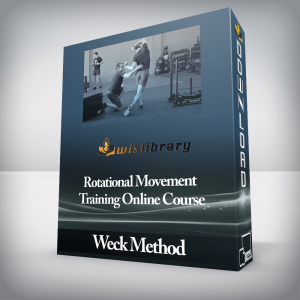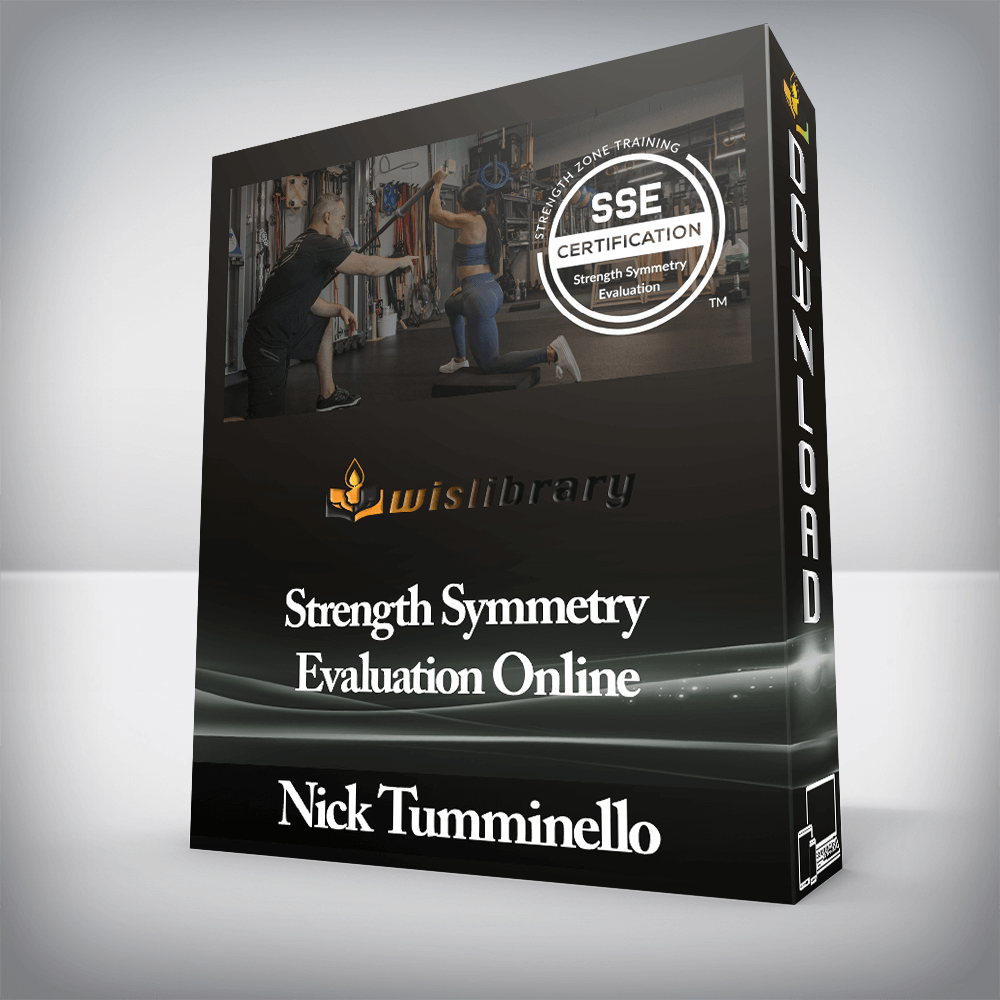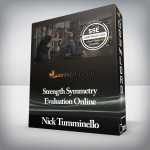Nick Tumminello – Strength Symmetry Evaluation OnlineThe Missing Evaluation for Identifying Strength Imbalances and Unlocking PerformanceYou assess clients all the time, but do you really know what you’re looking for?How do you know which asymmetries or imbalances to fix and which to leave alone?Do you wish you had a simple, practical, and reliable way to discover and improve the strength imbalances that are robbing your clients of performance and putting them at risk of injury?A solution has arrived.The Strength Symmetry Evaluation (SSE) is the first evaluation tool that allows you to quickly and easily identify and correct sub-optimal strength imbalances in your clients and athletes that lead to poor performance and increased injury potential.Featuring 8 critical strength symmetry tests, the SSE is simple to perform, time-efficient, and it blends right into a training session seamlessly.You’ll gain more clarity on where to focus your training program to deliver demonstrable results that your clients and athletes will love.Spend less time guessing and more time progressing.You’re not training it optimally unless you’re testing it properly.If you’re a trainer or coach that works with clients or athletes, then you already know that almost everyone has some type of strength imbalance.Maybe one arm is stronger, maybe their jump is higher when pushing off one side, or maybe they can perform an exercise perfectly on one leg and cannot complete a single repetition on the other.Despite our bodies looking symmetrical, they almost never perform that way without some type of directed training. But you can’t train it if you can’t test it.And how do you know which imbalances need to be fixed in the first place?Unfortunately, it’s not as simple as just programming a handful of unilateral exercises and hoping for the best. That might actually make the problem even worse.Instead, you need a need a way to identify which strength imbalances are actually a problem and give you a simple solution to correct them that works with any assessment process that you are already using.The Strength Symmetry Evaluation does just that.By using 8 easy to perform tests, you’ll be able to discover and correct sub-optimal strength imbalances, program and prescribe the right exercises and volume for ideal strength symmetry, and increase performance while reducing injury risk in clients and athletes.Assessments VS Evaluations: You Need BothAssessments and screens look at movement quality, but they don’t look at strength symmetry levels.While assessments and screens are designed to tell you how your clients are moving, the SSE tells you their current areas of strength imbalances that need to be improved.Assessments are performed with clients and athletes to tell us what exercises they can do safely and which variation is most suitable.Evaluations are designed to tell us what exercises they NEED to do.The best training programs need assessments and evaluations for optimal results. Think of them like a map and a compass: you need the compass (assessment) to find the right direction, but the map (evaluation) shows you the route to take.The Strength Symmetry Evaluation (SSE) is the missing follow-up evaluation to any new client assessment process you may already be using.What separates the best professionals from the rest is the best are always looking for ways to get even better results than they’re currently getting.The SSE doesn’t attempt to change how you train or test your clients and athletes. It’s a tool to help you train and test better.Plus, unlike other assessments and screens, each of the 8 different strength symmetry evaluations are not interrelated. The SSE is set up so that each individual test can be used as a stand-alone data source for training that you can keep coming back to.This enables you to fill in the gaps to your own assessments by taking your favorite elements from the SSE and integrating them into your own system.Streamline and Simplify Your Path to ResultsTo save time and avoid potential issues, you need data that tells you exactly what to do and demonstrates results without being too complicated or taking too long.Many assessments require a long barrage of tests that require significant planning and eat up valuable time. The SSE does neither and can be incorporated into a training session so you can be effective and efficient.The Strength Symmetry Evaluation gives you the valuable data needed to quickly identify and quantify the areas of weakness so you can be precise in where and how you build strength in your clients.With each test only taking minutes to perform and score, you’ll be able to run the SSE time and time again to gauge progress demonstrate improvements. Your clients and athletes will see progress in real-time and be motivated to keep following the plan.By implementing these 8 critical strength symmetry tests, you’ll know exactly which strength imbalances need to be corrected and how to do it.Featuring 9 Comprehensive And Practical Learning ModulesModule #1 – Assessments vs. Evaluations1.1 – Why an evaluation is different than an assessment.1.2 – Why assessments are only half the puzzle.1.3 – Why we need to do evaluations to fill in the gaps.1.4 – Which should you do first: An Assessment or an Evaluation?1.5 – Why the SSE is the perfect follow up, and great for advanced clients and athletes.Module #2 – What the SSE Is (and Isn’t)2.1 – The SSE is an evaluation tool designed to identify strength asymmetries that can cause reduced performance and increased injury risk.2.2 – Why the SSE works for real-world performance.2.3 – The science-based baseline cutoff standard the SSE uses.2.4 – How the SSE works to separate the asymmetries that need to be fixed from the ones that don’t.2.5 – The 2 types of asymmetries you shouldn’t try to fix.2.6 – Why the SSE isn’t about improving 1RM strength in barbell lifts2.7 – Why the SSE is designed to improve functional capacity and reduce injury risk in athletes and fitness enthusiasts.Module #3 – SSE Science3.1 – The SSE is based on a peer-reviewed approach.3.2 – Research clearly shows asymmetry provides insights into injury risk, rehabilitation, and performance.3.3.- The scientifically demonstrated best exercises for identifying the asymmetries that matter.3.4 – The optimal strength symmetry ratio3.5 – Research validates the SSE baseline cutoff standard3.6 – Is there any counter-evidence?3.7 – How much asymmetry should be allowed?3.8 – Dispelling the strength symmetry myth3.9 – The biggest lies about asymmetries (that trainers believe)3.10 – Fake Strength: Why bilateral lifts don’t fix asymmetriesModule #4 – SSE Guidelines and Scoring Criteria4.1 – Essential testing procedures: how to apply the scoring criteria correctly for accurate testing results4.2 – Testing technique vs. training technique: How are they different?4.3 – Proper range of motion for testing4.4 – Proper loading and rep range for testing4.5 – What to test and before you test: You must do this first before you start each evaluation.4.6 – The common mistakes to avoid when performing the evaluationsModule #5 – Lower-Body Strength Symmetry Evaluation5.1 – The 4 main lower body strength asymmetry evaluations5.2 – The 4 regressions for each evaluation to evaluate anyone5.3. – The 2 best single leg strength symmetry evaluation moves5.4 – The 2 missing aspects of lower-body strength that you need to test and train for performance and injury risk reduction5.5 – Double duty evaluations that test mobility and strength symmetry5.6 – How this popular glute training method is promoting a strength imbalance that increases the risk of groin strainModule #6 – Core Strength Symmetry Evaluations6.1 – How strong is your core, really? These two tests will tell you if your core is strong, and which side is your weak link6.2 – Lateral core strength symmetry evaluation6.3 – Rotational core strength symmetry evaluation6.4 – How to increase core stability in a more precise manner than ever beforeModule #7 – Upper Strength Symmetry Evaluations7.1 – The shoulder-friendly pushing strength symmetry evaluation7.2 – The pulling strength symmetry evaluation7.3 – Why you have to use this specific body position and range of motion in order to get accurate testing resultsModule #8 – Push-to-Pull Strength Ratio Evaluation8.1 – The horizontal push-to-pull strength ratio test8.2 – Do you really know your ratios?8.3 – What the optimal horizontal push to pull strength ratio is (based on research).8.4 – Should you really pull double what you push? It’s not what you think.8.5 – What even the smartest trainers get wrong about pushing to pulling strength.8.6 – The most intelligent way to program pushing and pulling exercises.Module #9 – Program Design and Best Exercises for Correcting Asymmetries9.1 – How to use the SSE results to be more precise with your exercise prescription and design more purpose-driven programs that provide both short-term gratification and long-term success9.2 – SSE Programming principles for selecting the best exercises and amount of sets and reps to correct strength asymmetries9.3 – Getting Unilateral and Bilateral Lifts Right: Knowing when to prioritize which9.4 – The best way to order exercises in a program to correct strength imbalances9.5 – The ideal amount of sets to do in order to fix their strength asymmetries9.6 – The best rep ranges to bring up their weaknesses9.7 – The key lifting movement categories to choose exercises from each week in order to build an all-around stronger and more balanced body9.8 – The must-know exercises for reliably improving and maintaining optimal levels of strength symmetry9.9 – Top lower-body exercises9.10 – Top core exercises9.11 – Top upper-body exercisesThe Strength Symmetry Evaluation is Ideal For:Performance CoachesIncrease performance in your athletes and implement a standardized system that your whole coaching staff can follow.Personal TrainersIncrease client buy-in by demonstrating results your clients can see and set yourself apart from the competition.Physical TherapistsDetermine discrepancies in your patient’s upper-body, lower-body, and core strength for better rehab programming.Want A Sneak Peek Of The Course?Watch the entire first module of the Strength Symmetry Evaluation online certification by entering your information below.You’ll learn:The 5 key steps that make up my entire training systemThe difference between an assessment and evaluation and why you need both to be effectiveWhy the SSE is important and what it’s really testing that most trainers are missingAnd more!There are no reviews yet.Add a Review Cancel replyYou must be logged in to post a review.
 Carroll Performance – Program Design Level 1
₹35,192.00
Carroll Performance – Program Design Level 1
₹35,192.00
 Weck Method – Rotational Movement Training Online Course
₹13,114.00
Weck Method – Rotational Movement Training Online Course
₹13,114.00
Nick Tumminello – Strength Symmetry Evaluation Online
₹21,248.00






